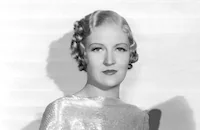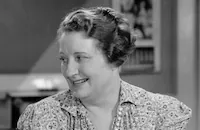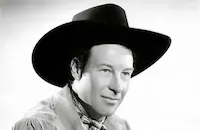Dr. Monica

Brief Synopsis
Cast & Crew
William Keighley
Kay Francis
Warren William
Jean Muir
Verree Teasdale
Emma Dunn
Film Details
Technical Specs

Synopsis
Monica Bradon, a happily married physician, is completely unaware that her husband John is having a love affair with her good friend, Mary. John and Mary end their relationship out of guilt, but when Mary faints during a party they are all attending, Monica learns that her friend is pregnant. Mary refuses to disclose the father's identity, but begs Monica to help her. Monica, who desperately wants a child of her own, personally handles Mary's medical care. As Monica is preparing to deliver the child, she overhears Mary telephone John and realizes the identity of Mary's secret lover. Although Monica is stunned at the news, her close friend Anna reminds her of her duty as a doctor, and Monica delivers Mary's baby. Anna encourages Monica to forgive and accept John, but Monica feels that with the birth of the child, he now belongs to Mary. Before Monica gives him up completely, she goes with him on a romantic vacation, after which she tells him that she knows his secret and that the only solution is that they divorce. Meanwhile, Anna convinces Mary that she must relinquish John, and in response to Anna's advice, Mary commits suicide by flying her airplane into the sea, leaving the baby's future to John and Monica.

Director

William Keighley
Cast

Kay Francis

Warren William

Jean Muir

Verree Teasdale
Emma Dunn

Phillip Reed

Herbert Bunston

Ann Shoemaker
Virginia Hammond

Hale Hamilton
Virginia Pine
Pauline True
Norma Drew
Leila Mcintyre

Edward Mcwade
Harry Seymour
Stanley Mack
Eric Wilton

Gordon Elliott
Marion Lessing
Reginald Pasch
Paul Power

Claire Mcdowell
Helen Jerome Eddy
Crew

Film Details
Technical Specs

Articles
Dr. Monica
The story, which Basinger calls "a top contender in the crackpot-plot sweepstakes," comes from a Polish play that was adapted into English as Doctor Monica and had a very brief New York run in 1933. The heroine is Monica Braden, a prominent obstetrician whose husband, John Braden, is a well-known author and also the secret lover of Mary Hathaway, a member of their social set who's rich enough to spend her time lounging around and taking friends for rides in her private plane. One evening Mary faints at a party, and Monica's trained eye sees right away that she's pregnant. What her trained eye doesn't see is that her own husband is responsible, that he's blissfully unaware of the pregnancy, and that his current absence on a trip to Europe is designed to make Mary stop loving him. Monica's own desire for motherhood has been thwarted by infertility, so she looks at her friend's predicament as a chance for some vicarious parenting. Recruiting her architect friend Anna to help out, Monica promises to care for Mary and deliver the baby when the time arrives, so the world will never know this ever happened. Increasingly distraught as her due date draws near, Mary tries desperately to reach John by phone, and when Monica overhears this, her husband's duplicity is a secret no more. Her first reaction is to storm out of the delivery room in a rage, but Anna appeals to her professional conscience, whereupon Monica does her obstetrical duty. (This is one of the rare movies where someone actually loses her head, gets a slap in the face, regains her wits, and calmly says "Thanks" to the slapper.) Then she tells John she wants a divorce. The resolution of the story involves a flight in Mary's plane, a sadly self-sacrificing act, and simultaneous solutions to Monica's frustrated motherliness and the baby's lack of properly married parents.
Francis was a major Warner Bros. star in the mid-1930s, thanks to her popularity in the melodramatic One Way Passage (1932) and the wryly comic Trouble in Paradise (made when she was on load to Paramount the same year). Critics have disagreed about the quality of her acting, however, and about whether it's even acting. According to Variety in 1934, "For all audiences, it will require considerable guesswork to determine whether Kay Francis, as Dr. Monica, is a doctor, which the picture portrays her to be, or just a clothes model, which the picture also portrays her to be....Miss Francis in this film is mostly a well-dressed lady who is acting; always acting." According to Basinger in 1993, "Obviously, Kay Francis can't act. Acting is not what she is doing on-screen. Being there is what she is doing, and at that she is an Olympic champion. She is presence, not talent." This seems a bit fussy to me presence has been a bankable talent for innumerable stars but even New York Times critic Mordaunt Hall, who praised Dr. Monica for its "excellent" acting, found no word stronger than "believable" to describe Francis's performance. Other reviews used similar terms, such as "competent" and "okay within the limitations of the script." Verree Teasdale generated more enthusiasm as Anna, and Warren William earned some praise as John, a character we're meant to like even though he's clueless and irresponsible by turns. "William, minus the mustache, with the loss not marking an improvement...plays a second rate sap in first class style," the Variety critic opined. Jean Muir also got good notices, even though playing Mary called on her to cope with a long list of narrative clichés.
Dr. Monica was recognized as a woman's movie from the start. "Women, because of the picture's plot, are the potential audience," wrote the Motion Picture Herald shortly before its release, adding that it contains "little to interest men" and is "far too deep and heavy for even the more mature adolescents." Variety agreed, predicting that "women will make or break this picture and it's not definite that a majority of the girls are going to go for it." Ironically, though, Francis found it not feminine enough. "I want to get away from the `new woman' the Dr. Monicas if I can," she remarked later, saying that "something essentially feminine" was the kind of part she preferred. She was on to something when she sensed that Dr. Monica wasn't an ideal character for her. Like her role in Mandalay earlier in 1934, the part had been written for Ruth Chatterton, who turned it down; then Jack Warner wanted Barbara Stanwyck to play it. And reviews were generally lukewarm when the picture opened. Adding to Francis's discontent with Dr. Monica was her growing dissatisfaction with being a movie star. "I don't particularly like myself in anything any more," she said about her performance. "Seems to me I'm always doing the same things with my hands and eyes and face. It makes you wonder just how much there is and is not to this acting business." The people who wondered whether Francis was "acting" apparently included Francis herself.
Dr. Monica has merits apart from the quality of its performances. One is its generous number of dexterous female characters besides the title physician there's Anna the architect and Mary the aviator. And its attitude toward sex is relatively open-minded, since the picture was released just weeks before Production Code censorship kicked in at full strength. Even then the Code office recommended that it be pulled from theaters because of references to adultery and pregnancy, and Code official Joseph I. Breen objected to characters he saw as a lesbian, a nymphomaniac, and a prostitute. Few would nominate Dr. Monica as Hollywood's best medical melodrama, but Francis's glamour somehow fits right in with its crackpot plot. And in my opinion, she is definitely acting all the way.
Director: William Keighley
Screenplay: Charles Kenyon, based on Laura Walker Mayer's adaptation of Maria Morozowicz-Szczepkowska's play
Cinematographer: Sol Polito
Film Editing: William Clemens
Art Direction: Anton Grot
Cast: Kay Francis (Dr. Monica), Warren William (John), Jean Muir (Mary), Verree Teasdale (Anna), Emma Dunn (Mrs. Monahan), Phillip Reed ("Bunny" Burton), Herbert Bunston (Mr. Pettinghill), Ann Shoemaker (Mrs. Hazlitt), Virginia Hammond (Mrs. Chandor), Hale Hamilton (Dr. Brent), Virginia Pine (Louise)
BW-53m.
by David Sterritt

Dr. Monica
Quotes
Trivia
Notes
The film's working titles were The Affairs of Monica and When Tomorrow Comes. According to a news item in Hollywood Reporter, Joel McCrea was considered for the male lead in the film. Warner Bros. records reveal that Jack Warner suggested Barbara Stanwyck for the leading role. Correspondence included in the file on the film in the MPAA/PCA collection in the AMPAS library recommended that the picture be pulled from the theatres for its violations of the production code, specifically its references to adultery and pregnancy. Joseph I. Breen, Public Relations Director of the AMPAA, also objected to the film's portrayal of women, identifying characters as a lesbian, a nymphomanic and a prostitute.
















